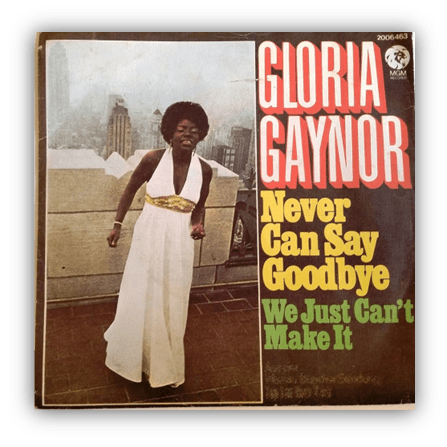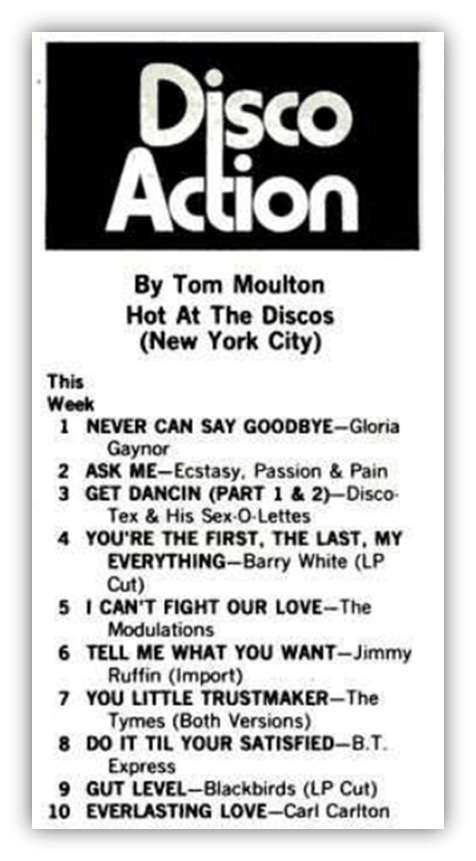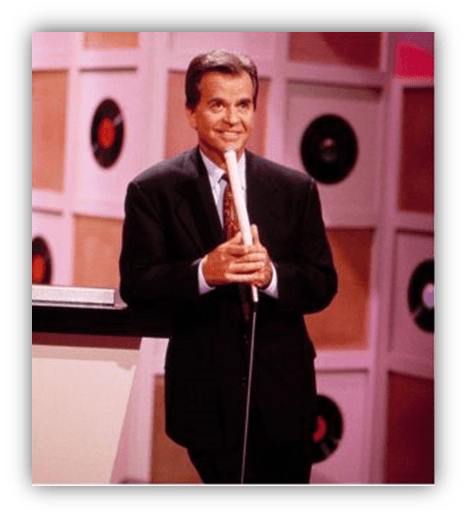The Hottest Hit On The Planet…

It’s “Never Can Say Goodbye” by Gloria Gaynor!
In the general pop consciousness, disco-cutie-pie Gloria Gaynor is the “I Will Survive” woman.
That makes sense: when you’ve released one of the most momentous mega-hits of all time, a karaoke-anthem for every woman scorned, anything else you’ve ever done is inevitably going to be relegated to “that other song she had” status. That’s assuming that it’s even remembered at all.
And that’s completely understandable.

After all, if you only have room for one Gloria Gaynor track in your “70s Disco” playlist, which track are you going to choose? “I Will Survive” or… “that other song she had…”
However, I would recommend that you do add “that other song she had” to your “70s Disco” playlist… not only is it almost as good…
It’s possibly more “historically important”! If you care about that sort of thing.

That “other song” that Gloria Gaynor had was “Never Can Say Goodbye”, and fans of chart trivia will be delighted to learn that it was the historic first Number One on Billboard’s Disco Action chart!
Although this was the first Disco Action chart, they must have been testing the chart for a while previously, because the commentary below it said that “Never Can Say Goodbye” had already been Number One in the discos for Five Weeks!
Billboard also included two sales charts for specific New York record stores:

Colony Records – on Times Square

– and Downstairs Records. Gloria was Number One on both of those charts as well.
This feels appropriate because Gloria Gaynor pretty much invented the Disco Diva.
There were divas prior to Gloria Gaynor, and there was disco prior to Gloria Gaynor, but those disco songs were either cheesy, such as “Rock The Boat”, or at least trying to be sexy, a la “Rock Your Baby.” Both of those “Rock” songs may technically be disco, but they weren’t DISCO!!! Neither was “Kung-Fu Fighting.” It was just a silly novelty party song about kung-fu fighting.
But “Never Can Say Goodbye” was DISCO!!!!

Listen to those SWIRLING DISCO STRINGS!!!

That hissing “psst-psst” hi-hat!!!
Is “Never Can Say Goodbye” the first record to put all these ingredients together? I’m not sure.
First Choice’s “Armed And Extremely Dangerous”, possibly the first ever disco record, seems to be based on a similar recipe, although it doesn’t quite get there. But “Never Can Say Goodbye” sounds like the future compared to the Number 2 Disco Action song; “Ask Me” by the excellently named Ecstasy, Passion & Pain.
Not to mention the Number 3 song by the even more excellently named Disco-Tex & His Sex-o-lettes – an act that really ought to be better remembered, if only for Barbara Roy’s eye-catching skunk-themed Afro!
Being Number One on the first ever Disco Action chart also feels appropriate, since “Never Can Say Goodbye” was produced – one might almost say “manufactured” – by the Disco Corporation of America.

This little outfit should not be mistaken for Disco Corporation, a Japanese manufacturer of precision tools
Even if the Disco Corporation of America used all the tools at their disposal to produce records precisely calibrated to hit your disco pleasure-centres.
The primary genius of the Disco Corporation Of America was Meco:

A serious slide-trombone player, and previously a bit-player in the jazz world.
Meco’s life was transformed when he heard Petula Clark sing “Downtown”, after which he appears to have thrown himself into pop music so hard that a few years later he’d record this:
Not only this, but the entire Star Wars and Other Galactic Funk album, the track listing of which includes “Star Wars Theme Medley”, and three other tracks, titled “Other” ,“Galactic” and “Funk.”
Later Meco releases would include “Encounters Of Every Kind”, “Meco Plays The Wizard Of Oz”, “Superman & Other Galactic Heroes” and “Ewok Celebration.” Meco loved nothing more than disco-tizing movie soundtracks from both long, long ago, and from galaxies far, far away.
So, it only makes sense that “Never Can Say Goodbye” was also a song from, well, not that long, long ago… only a couple of years really. But songs seemed to slip into golden-oldie status remarkably quickly back then.

Dick Clark would say things like “remember this one?” when introducing songs that were barely a year old.
Anyway, “Never Can Say Goodbye” was kind of an old song, and Meco disco-tized it. That was kind of his thing.
“Never Can Say Goodbye” was originally written by Broadway actor, Clifton Davis, and was initially meant to go to The Supremes. This sounds like a fabulous idea, particularly if Diana had sung it.
But she wouldn’t have because she had left the group by then.

And the new Supremes – with Jean Terrell – weren’t exactly a dominant chart force anymore.
So it went to Motown’s new, more reliable-chart-phenomenon, The Jackson 5!
The Jackson 5 version is an effervescent funky thing, and those “no-no-no no-no-no no-no-no eeeeeeeeeewwwwww!!!!” bits are f*cking gold. But I still think it would have been better with Diana; perhaps because I think of “Never Can Say Goodbye” as a girl’s song (The Jackson 5 version is a 7.)
Most definitely not a girl was Isaac Hayes:

Indeed, Ike might be one of the manliest men who ever lived. –
But he still jumped on his own version, a sure sign that “Never Can Say Goodbye” was a pop classic in the making. Isaac Hayes was a man who knew a classic pop song when he heard one. This was the period in which Isaac seemed to be recording virtually nothing but classic covers of classic pop songs:

“By The Time I Get To Phoenix”, “(They Long To Be) Close To You”, and a whole bunch of other Bacharach songs…
Each time making them better than the originals. Better, and very much longer. All the while creating grooves and hooks that would be sampled more times than you might think possible.
The Michael and Ike versions are fine and all, but they don’t quite capture the necessary inner-turmoil, do they? That anguish and that doubt. They don’t quite capture that Disco-Diva-Drama. Gloria does! Gloria thinks she’s had enough, she starts heading for the door… but there’s a very strange vibration, piercing her right to the core. She probably means sex.

Gloria definitely means sex on the B-side, “Honey Bee”, which starts off, because of course it does, with the buzzing sound of a bee: “you’re my honey bee” Gloria purrs flirtatiously, ”come sting me.”
Oh yeah, it’s definitely about sex. Or at least I’m pretty sure it’s about sex. Is this about sex?
“You’re always so busy
Workin’ on love’s honeycomb
Chalk full of sugar down your sweet mouth”
So…
- Disco Diva
- “psst psst” hi-ha
- SWIRLING DISCO STRINGS
- sex…
All the disco ingredients were in place. So why would it take almost half a decade for Gloria to have another hit with… you know the one. What was Gloria doing in all that time?
Having had such success with one cover of a golden-oldie, Gloria tried it again with disco covers of “Reach Out, I’ll Be There” and “Walk On By.”

(Curiously, Isaac Hayes had also covered “Walk On By”, a 12-minute epic string-laden soul-vamp which made him famous amongst anyone who didn’t read the liner notes of Stax Records, and it’s a 10.)
And when nobody outside of the discotheques of Europe seemed to care about them, she went even further back to drop disco versions of 50s vocal-jazz standards such as “How High The Moon” and… are you ready for a disco version of “I’ve Got You Under My Skin”?
Neither was anyone else.
“Never Can Say Goodbye” is a 9.
Meanwhile, in Reggae Land:

It’s “No Woman, No Cry” by Bob Marley
Bob Marley is a reggae singer. Obviously. You know that. But, equally obviously, he’s more than that. He’s a guru. A poet and a prophet (to quote Sir Anthony Kiedis). He’s the Jamaican John Lennon. He’s Che Guevara, The Musical.

Bob Marley was a legend.
And part of the reason for his being a legend was because he made his upbringing and his background sound legendary, too. And on no hit did he do this better than on “No Woman, No Cry.”
“No Woman, No Cry” – which apparently just means “woman, don’t cry” – was a nostalgic lament about sitting in the government buildings in Trench Town, eating corn meal porridge.
A lot of Bob Marley songs are about those days.

You can go to the shanty where Bob shared the shelter of his single bed (ala “Is This Love?”), or at a least a shanty that your tour guide will tell you is that shanty.
But no other Bob Marley hit goes into quite as much detail about the neighbourhood in which Bob grew up: the neighbourhood of Trench Town.
Trench Town – or Trenchtown – was a 200-acre government housing project.

Before that, it was a squatter’s settlement. And before that, a plantation estate owned by the Trench family before an earthquake destroyed it all.
It was in this neighbourhood that first ska, and then rocksteady, and then finally, reggae, was born.
Throughout the 60s, artists from Trench Town were taking over the airwaves and sound-clashes and record stores of Jamaica – and increasingly the UK. But this didn’t seem to be benefiting anyone else in Trench Town, which instead, was turning, more and more, into a slum. As things looked more and more hopeless, the music became more and more slow, the lyrics more and more political. This slower, more political music was reggae.
Bob Marley began his music career during the most uptempo, optimistic era, when he – and Peter Tosh and Bunny Wailer – made a bunch of records with Leslie Kong:

A Chinese-Jamaican record producer; people in the Jamaican reggae scene referred to him as The Chinaman.
Kong had gotten into the record industry in the early 60s when he owned an ice-cream parlour with a record store attached, called Beverly’s. Jimmy Cliff wanted Leslie to record him – I’m unclear as to why, since Leslie had never recorded anyone else before, and he didn’t know how – so he wrote a song called “Dearest Beverly”, in an attempt to suck up to him.
Incredibly, it worked. Leslie made some Jimmy Cliff records, and even more incredibly they worked. Leslie would end up spending the 60s producing pretty much every ska, rocksteady, and reggae classic. That’s including Desmond Dekker’s “Isrealites”, a UK Number 1!
And also a bunch of Bob – and Peter and Bunny – hits, back when they were calling themselves, first The Teenagers, then The Wailing Rudeboys, then The Wailing Wailers, and finally, just The Wailers. Back then, they looked like this.

Back then, Bob Marley wore a suit and tie!
Back then, they sounded like this: This is “Simmer Down”, a huge hit in Jamaica in 1964.
Unfortunately for Leslie, this would ultimately lead to his demise.
It was 1971 and The Wailers had recorded what were supposed to be just a bunch of demos with Leslie. But the band, or at least Bunny Wailer, were not too keen on the end-result.

Bunny told Leslie that if he released the tracks, he would put a curse on him.
Leslie didn’t listen, released the misleadingly titled The Best Of The Wailers – a greatest hits compilation featuring no hits – and died of a heart attack a week later.
Now The Wailers needed someone else to help them make hits.
Since they were in London at the time, they popped into the offices of Chris Blackwell, who we’ve previously discussed in our post on Millie Small’s “My Boy Lollipop.”

The boss of Island Records, and thus the man responsible for marketing everything from prog-rockers Emerson, Lake & Palmer and Jethro Tull, to hippie-folkie stuff with Cat Stevens.
When Bob and the rest of the Wailers turned up at Chris’ office, Chris’ first reaction was “f*ck, this is the real thing” (clearly Chris hadn’t seen the photos of the group in 1964), and to formulate a crazy idea of marketing Marley, not as an R&B singer, but as something closer to a rock star. As rebel music. For white rock fans.
As someone to fill that Jimi Hendrix-shaped hole. So he added some rock dudes to the band, to make it easier for rock fans to understand the music, and he doubled down on the one thing that everybody knows about Bob Marley: that he smoked a lot of spliffs.

Bob smoked a lot of spliffs because he was a Rastafarian, a mysterious religion that had boomed in Jamaica, and particularly in Trench Town, during the 60s, with reggae evolving alongside it.
The Rastafarians believed that Africa was being oppressed by Western society, or as they called it, Babylon. Nothing too controversial about that, I suppose, but they also believed that Ethiopian Emperor Haile Selassie was the second coming of Christ, much to the confusion of Haile himself. Bob Marley even wrote a song about Haile: “Iron Zion Lion.”
The fact that there was a rock star smoking marijuana as a fundamental part of his religion was a huge draw to hippies of a certain hue. The fact that it was hard to find a photo of Bob Marley in which he wasn’t surrounded by a cloud of ganga smoke, was likely the key to his popularity.

Bob’s association with ganga was so strong that his Catch A Fire album – it has “Stir It Up” on it – was designed to look like a Zippo lighter.
This turned out to be a not exactly profitable-packaging option.

So they went with a photo of Bob smoking a novelty-sized spliff instead.
Bob was willing to go along with Chris’ plan to market him as a ganga-smoking rock star. Bob wanted to be famous. Being a famous rock star was better than what he was doing the first time he was living in America, in the mid-60s: being a laboratory assistant for DuPont and a forklift driver for Chrysler. I’d like to pause for a minute, so that you can imagine Bob Marley working in either of those professions.
The attempt at appealing to white rock fans was obviously successful, as demonstrated when Eric Clapton had a huge hit with Bob’s “I Shot The Sheriff.”
Then came “No Woman, No Cry.”
“No Woman, No Cry” appeared at the same time as Bob had added three women to his band, to be his backing singers.

He called them The I-Threes, and they included his wife Rita.
But for “No Woman, No Cry”, the backing singers appear to be… the entire audience. Everybody would sing along to that communal chant of a chorus. Chris Blackwell noticed this, and turned up the crowd noise on the live recording as high as it could possibly go, so that we could all feel as though we were there and sing along. A year or so later, that live version would become a UK Top 40 hit.
The money from “No Woman, No Cry” went to a good cause. Or at least it went to a good man. A man named Vincent Ford.

A man who ran a soup kitchen in Trench Town.
A man who lost his legs due to diabetes and had to go around in a wheelchair. A man who still managed to save someone from drowning. A man who may or may not have helped write “No Woman, No Cry,” but Bob put his name on the copyright anyway.
This was partially because Bob was trying to get around certain contractual issues.

And partially because Bob was just a really nice guy who wanted to give back to his community. What a guy!
Or maybe Vincent did help write “No Woman, No Cry.” Bob and Vincent had grown up together in Trench Town. They still hung out together a lot. They liked to reminisce about old times together. Maybe it was Vincent who said remember when we used to sit, in the government yard in Trench Town? That’s worthy of a co-writing credit, surely?
But yeah, Bob Marley, what a guy!
I mean, really, what a guy!
This was a guy who, a year later, in an attempt to unite the nation at a time when the two main political parties – the People’s National Party and the Jamaican Labor Party – were warring in the streets, each party having their own rampaging gun-toting gangs, would hold a free-“Smile Jamaica” concert.

Both the Prime Minister, Michael Manley, and the Opposition Leader, Edward Seaga – previously a record producer who owned West Indies Recording Limited, the hottest label in Jamaica in the early 60s – would be on stage together!
Such was the Bob-mania in Jamaica at the time that this appears to have been enough for the Prime Minister to call a snap election for ten days after the concert, hoping to benefit from the Marley momentum.
Not everyone was happy about this, not least of all the Jamaican Labor Party, who, may or may not have ordered a hit on Bob. Possibly in conjunction with the CIA and a drug lord. Whoever was behind it – and some believe that it was the People’s National Party in order to make a martyr of Bob (personally I suspect the hit was supposed to be on Prime Minister Manley himself, but the hitmen got confused because Bob Marley was more famous.)
They invaded Bob’s headquarters and attempted to assassinate him.

A bullet hit Rita in the back of her head, but the thickness of her dreadlocks saved her.
A bullet grazed Bob’s chest, and also hit his forearm, but otherwise he was fine, because he remembered a dream that he’d had a couple of days before: he dreamt that people were trying to kill him, when God – or Jah – told him “don’t run—stand up.” Incredibly, such a strategy worked.
Sad to report, this is not also the story of how Bob wrote “Get Up, Stand Up.” That song was already three years old. Nonetheless, Bob didn’t give up the fight.

The concert went ahead, Bob voicing the immortal words: “The people who are trying to make this world worse aren’t taking a day off. How can I?”
What a guy!
And Michael Manley won the election.
“No Woman, No Cry” is a 9.
Meanwhile, In DyLan-d:

It’s “Tangled Up In Blue” by Bob Dylan
OMG… it’s another Bob!!!!
My favourite Bob Dylan songs are the ones in which there are simply too many lyrics. Confusing lyrics. Surreal images, Obscure references (which, in this case, Bob himself doesn’t quite seem to understand). Entire worlds of characters and their implied backstories.
“Tangled Up In Blue” more than qualifies.
“Tangled Up In Blue” was the only single from Blood On The Tracks, an album generally agreed – by everyone except Bob himself, who says it’s based on Chekov – to be Bob’s divorce album.

Or at least – since Bob and Sara wouldn’t get divorced until 1977 – an album about two people who no longer understand each other.
Despite all of Bob’s protestations, “Tangled Up In Blue” is definitely about Bob and Sara: after all, Sara was still married when her and Bob first met, and she was soon to be divorced. But now the tables were turning, and it was Bob and Sara who couldn’t understand each other.
And the reason why Bob and Sara could no longer understand each other? Bob was learning to paint.
Bob was being taught by Norman Raeben.

Never heard of him? That’s okay. Neither has anybody else.
As Bob once told a Playboy journalist – everyone was doing Playboy interviews at the time, even Jimmy Carter – he was “just an old man. His name wouldn’t mean anything to you.”
But Norman did seem to be good at words – the title “Tangled Up The Blue” was how he described one of Bob’s paintings – and he had a lot of ideas. Ideas about… well, here’s Bob, talking about some friends of Sara’s who had come around:

“They were talking about truth and love and beauty and all these words I had heard for years, and they had ‘em all defined. I couldn’t believe it… I asked them, ‘Where do you come up with all those definitions?’ and they told me about this teacher.”
So Bob goes to see the teacher and…
“In this class there would be people like old ladies — rich old ladies from Florida – standing next to an off-duty policeman, standing next to a bus driver, a lawyer. Just all kinds. Some art student who had been kicked out of every art university. Young girls who worshipped him… a lot of different kinds of people you’d never think would be into art or painting.

“And it wasn’t art or painting, it was something else… He talked all the time, from eight-thirty to four, and he talked in seven languages. I don’t even remember 90 per cent of the stuff he drove into me.”
“I went home after that first day and my wife never did understand me ever since that day. That’s when our marriage started breaking up. She never knew what I was talking about, what I was thinking about, and I couldn’t possibly explain it.”
I guess “Tangled Up In Blue” is Bob’s way of trying to explain it.

Although, as usual for Bob, it’s not exactly clear, even without the influence of an art teacher/spiritual guru.
“Tangled Up In Blue” is one of rock’s greatest love stories… you could make a movie out of it, although it still wouldn’t make any sense.
It’s a lifetime of two people drifting into and out of each other’s lives…

…she looks over her shoulder, promising “we’ll meet again someday, on the avenuuuue” … and they do…
In between stints as a cook in the woods or working on a fishing boat off New Orleans, they run into each other again and again, and in the most unlikely of places… a topless bar, during a revolution in Brooklyn.
In the former she only sort of recognizes him, but she still gives him a book of Italian poems from the 13th century, as you do (what was such a book even doing in a topless bar?)… and she ties the lace on Bob’s shoe, as you do (this may be the most enigmatic lyric in an already obtuse song, and has led to much fan debate, usually along the lines of: is she giving Bob a head-job?)… and it goes on and on.
Bob had always sounded old, even when he was young. But in “Tangled Up In Blue,” there’s almost the sense of an old man looking back on his life as it flashes in front of his eyes.
And realising that it still doesn’t make any sense.
“Tangled Up In Blue” is a 10.

Let the author know that you liked their article with a “Green Thumb” Upvote!






As a side note: it may just be me, but every time I have “Tangled Up In Blue” in my head, there will be a moment when it suddenly switches to “Centerfold”
“Some are mathematicians
Some are carpenters’ wives
Don’t know how it all got started
I don’t know what they’re doin’ with their lives
Years go by,
I’m lookin’ through a girly magaziiiiiine
And there’s my homeroom angel
On the pages in-betweeee-eeeeen…
Tangled up in blue!!”
Dan I absolutely love these involuntary song mashups that our brains come up with. I have a number of them that are very much like yours. You can’t escape it…your brain just goes there.
I feel a little like an oddball, cause I’ve always liked Gloria’s version of “Never Can Say Goodbye” even more than “I Will Survive”. I just think it’s a great song!
In that case, welcome to this meeting of Oddballs United: I’ve always thought that NCSG > IWS.
Anthemic nature aside, overall: it’s just a better record.
It may be that I Will Survive has suffered from overplay but I prefer Never Can Say Goodbye as well.
I think “I Will Survive” is a good song, but “Never Can Say Goodbye” is one of my all time favorite disco songs. A 10/10 every day. (And I didn’t know about the Meco connection till today!)
I hear echoes of the Influence of “Tangled Up in Blue,” both in lyrics and production, in later (and bigger) pop songs such as “The Killing of Georgie” by Rod Stewart and “Romeo’s Tune” by Steve Forbert. And I bet both Stewart and Forbert would argue that Dylan had no influence on their songs, and I wouldn’t argue with them if pushed, but still ….
Gloria Gaynor was so big with “Never Can Say Goodbye” that she got crowned Queen of Disco at a ceremony after it became a hit. Then Donna Summer arrived in 1976 and unofficially snatched the title away from her. That’s why I’ve always viewed “I Will Survive” as just as much a statement of her resilience in the music industry as it is a relationship anthem.
“Tangled Up in Blue” is, indeed, the tenniest of tens. That album came out while I was in high school, and listening to it for the first 100 times (which was in the first week after I bought it) felt like my life was literally changing around me. Nothing was ever quite the same.
I somehow missed that the Jackson 5 had first go with Never Can Say Goodbye. It just doesn’t sound right with Michael’s squeaky voice.
After Never Can Say Goodbye and I Will Survie, Gloria had one more European hit with an anthemic disco anthem. I Am What I Am outlived disco to give her a #13 UK hit in 1983.
I love the early 60s photo of Bob, Bunny and Peter. Bob has a Smokey Robinson thing going on while Peter Tosh standing literally head and shoulders above them looks incredibly cool and intimidating. I got into Bob as a teenager, it seemed a rite of passage in the mid teens to assert your credentials as someone of more discerning tastes. As well as all that marijuana imagery offering a safe way of rebellion for kids that had never been near a spliff. First box set I ever bought was Songs of Freedom with five hours of Bob spanning 1961 to 1980.
No Woman, No Cry isn’t in my top 10 Wailer songs but it’s still an 8.
NCSG was the change up from the joyous energy of the trifecta of “I Want You Back”, “ABC”, and “The Love You Save”.
I remember being fascinated that they would release a slow ballad to follow the up-tempo hits.
Thanks for including “Simmer Down.” It’s a ska classic.
Another gem of an article – thank you!
I’m not enthusiastic about some folk music, so I’d never heard “Tangled Up in Blue” before today. I’ve got to admit, I like it at first listen. That’s a good song. I need to listen to the studio version.